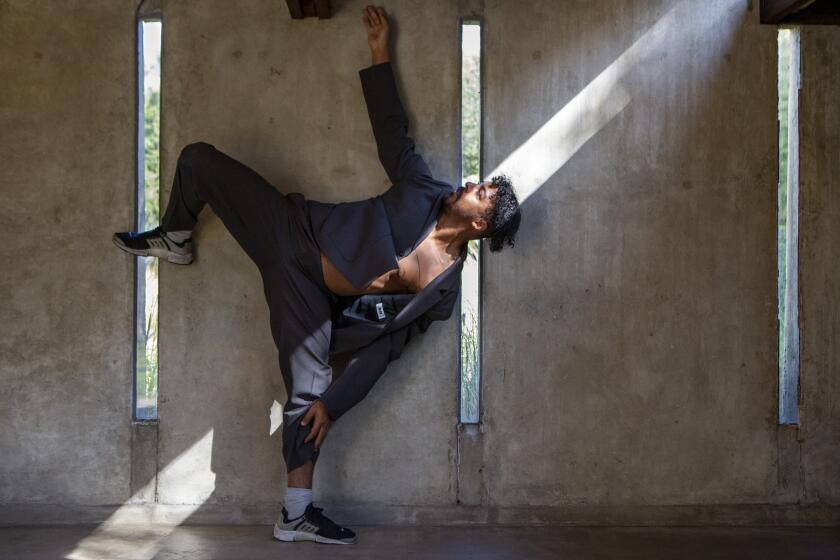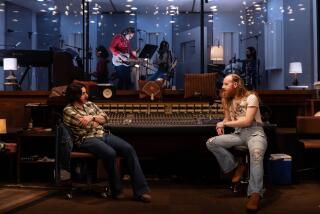Commentary: Theaters nobly fill the COVID void, but screens make me miss the stage even more
Zoom theater is an oxymoron, but substitutes for live performance will have to do until we can safely gather again as an audience.
The Old Vic’s In Camera program demonstrates what can be done with an actor on stage alone or physically distanced from a scene partner. The offerings, scratch productions with topnotch performers, recall Peter Brook’s idea of theater as “the empty space,” the stage equivalent of a blank page, requiring nothing more than the imaginative interplay between artists and (implied) spectators.
But what about more adventurous digital performances? My encounters thus far don’t persuade me that the future of theater lies in sophisticated tech.
When I tune into a play or a devised theater piece, I’m not looking to be dazzled by computer graphics. Clever Zoom backdrops don’t seize my imagination. I want what I always want from the stage: a confrontation with what it means to be human.
COVID-19 prompts L.A.’s popular free Shakespeare festival in the park to conceive “Romeo and Juliet” as a distanced, livestreamed affair.
That was not at all my experience with “Portaleza,” a piece by David Israel Reynoso and the immersive theater company Optika Moderna in La Jolla Playhouse’s digital Without Walls series (available through Oct. 31). A package was mailed to my home with a “hypnocular device” that I had to fold together myself. (For someone who quakes in terror at the words “special assembly required,” this was not an auspicious start.)
To access this mysterious portal, I had to scan a code with my phone, then (after some instructional confusion) email a message to a dead loved one that would be coded by an Optika Moderna optician for cosmic delivery. The message I scrolled wasn’t to a dead loved one but to the artists behind this cumbersome exercise: “This is manipulative and exploitative.”
Eventually my misshapen hypnocular device came into play so that I could experience “a surreal vision” of my “message’s passage through the hands of celestial and mortal beings.” Part video game, part music video, the piece was surreal all right. But missing for me was anything resembling a theatrical vision.
I was eager to see how Pig Iron, the inventive Philadelphia-based theater company, would translate its experimental sensibility on Zoom. But the lesson from “Zero Cost House,” a semi-autobiographical play written for Pig Iron by Japanese playwright Toshiki Okada, is that the digital space, while open to new configurations, can handle only so much dramatic complexity.
The play, which the company performed onstage in 2012, has been adapted to a new medium. The fit doesn’t feel natural. Adapted and directed by Dan Rothenberg and translated by Aya Ogawa, this online incarnation of “Zero Cost House” is unwieldy, slow to take off and only intermittently arresting.
The characters include a Toshiki Okada from 15 years earlier when he fell under the spell of Henry David Thoreau’s “Walden” and a Toshiki Okada who has grown disenchanted with the book and its classic American inquiry into nature and society and freedom and responsibility. The actors circulate parts, lending identity an even more slippery reality in a work that offers no more incentive to follow along than a stranger’s dream.
Pig Iron’s unhurried performance style can be a source of delicious deadpan humor, but it’s not easy to duplicate the insider drollery online. The slowness felt tedious, especially when rabbit puppets, characters of a play within the play, were added to the mix.
Big questions, derived from Thoreau (who appears in a casual modern guise), about how to live as an artist and a politically conscious citizen are taken up. Bjork’s music, an obsession for Okada, is playfully evoked. Disaster, in the form of the 2011 Fukushima meltdown, ratchets up the stakes of the artist’s soul-searching. But the overall effect of this talky, shapeshifting piece is numbing.
Staring into a computer screen for a protean two-hour performance work is testing. Attention spans that are already fractured by a global pandemic and a hot political war need perhaps a sturdier structure than the whimsical foundation on which “Zero Cost House” rests.
Bringing the blithe spirit of Pig Iron’s avant-gardism to Zoom is an admirable effort, but both the tumultuous nature of the times and the specificity of the technological platform must be more carefully considered. Resonance is not enough. And old aesthetic maps can’t be mapped onto new aesthetic geographies.
The Fountain Theatre has brought Ifa Bayeza’s “The Ballad of Emmett Till” to the web (streaming through Dec. 1) in a reimagining of its 2010 production directed by Shirley Jo Finney. The timeliness of this tragic tale, about the 14-year-old Black boy from Chicago who was lynched in Mississippi in 1955 after being accused of flirting with a white woman in her grocery store, is painful.
Till’s death gave force to the burgeoning civil rights movement. Bayeza tells his story as a lyrical collage, conjuring in spoken-word rhythms the irrepressible vibrancy of a carefree spirit who was cut down in his youth by racist violence.
This ensemble piece, a communal chorus of witnessing, had a capering quality in the theater as it summoned Till back to life. Language was the main form of illustration.
The focus is no longer on the actors’ relationship to the words that Bayeza finds to reanimate a crushing story. On Zoom, the performers are situated amid backgrounds (a train, a cotton field, a car, clouds) that shift in style between graphic novel and live animation. There’s nothing inherently wrong with the sprightly design, except that it detracts from the poetry, competes with the performers and turns the play into an educational cartoon.
“The Ballad of Emmett Till” humanizes history that sadly hasn’t lost its urgency. But technology renders the work less potent than it was on a simple stage.
Digital theater is offered as a consolation, but so much of the work inadvertently underscores the social isolation of the pandemic. Acting depends on listening, but Zoom seems to be all about speaking. Actors, stranded in their boxes, seem exclusively focused on their characterizations and cues. Other people’s lines barely seem to register.
There have been notable exceptions, such as the well-honed ensemble of Richard Nelson’s Apple family Zoom trilogy. But an impersonal quality has dominated. The orgone box style of acting — hermetic, self-engrossed — is back with a vengeance.
Zealous mugging is in evidence early on in the online presentation of Madhuri Shekar’s “In Love and Warcraft,” a collaboration between San Francisco’s American Conservatory Theater and Alaska’s Perseverance Theatre, directed by Peter Kuo.
The supporting players are particularly guilty of overselling their characters. Trust isn’t easy to achieve when working alone together.
The director’s determination to make it seem as though two or more actors are in the same room by having them look sideways rather than straight ahead occasionally leads to some cutesy business. Oh look, they’re pretending to share potato chips. Ha, ha, ha, they’re supposed to be smooching now. I will admit, however, I was impressed by the daring when a gynecological exam was administered. (Surely this must be a first for Zoom theater.)
The play tells the story of Evie (Cassandra Hunter), a college senior who prefers to live her life virtually. She spends nearly all her free time in the online role-playing game World of Warcraft. For extra cash, she writes letters (à la Cyrano de Bergerac) to those needing to win back their lovers.
Romance terrifies her, until she meets Raul (Hernán Angulo), who requests her epistolary services for a faulty relationship he’s not even sure he wants to salvage. A rambunctious rom-com for the screen generation that has an obvious destination in view, the play would have benefited in this digital format from some judicious pruning.
But something happens along the way that lifted this Zoom offering from its screen prison: intimacy between the leads. I’m not speaking only about the love that develops between Evie and Raul, though that of course is the dramatic vehicle.
I’m talking about the connection between Hunter and Angulo, who seem to be responding to each other in the moment, reacting to the emotions they’re taking in. The feeling isn’t freeze-dried. As their characters bridge their loneliness, the actors bridge ours with the genuineness of their performances.
This presentation of “In Love and Warcraft” (available on demand through Sept. 25) is remount of a spring production with A.C.T.’s MFA students. The play cleverly incorporates a version of the Warcraft game to bring the action to a happy close, but computer ingenuity is not what gives life to the production.
At a time when so much of our lives are lived on the internet, we don’t need to spend elective hours admiring technological wallpaper. Art has a greater imperative: to restore the link to our humanity. Digital performance will be in a better place when it worries more about human contact than superficial spectacle.
Chris Emile’s show about Black masculinity premiered in March at the MAK Center in West Hollywood. How he’s resurrected it, with pandemic precautions.
More to Read
The biggest entertainment stories
Get our big stories about Hollywood, film, television, music, arts, culture and more right in your inbox as soon as they publish.
You may occasionally receive promotional content from the Los Angeles Times.












